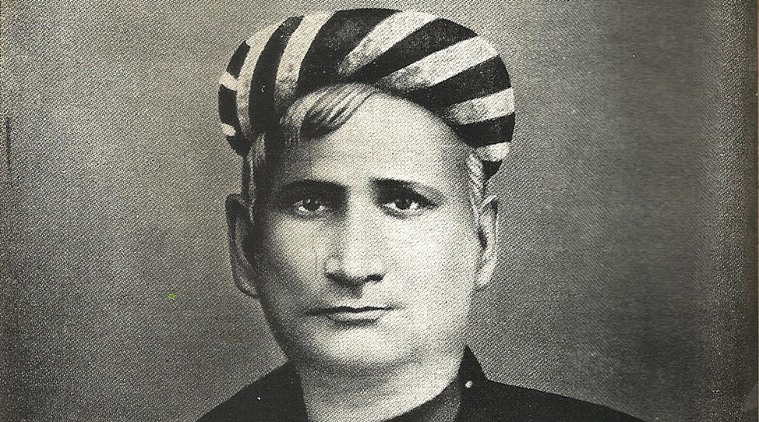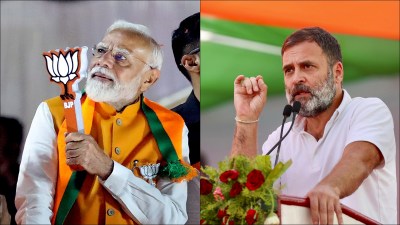- India
- International
Remembering Bankim Chandra Chattopadhyay, the face of Bengal renaissance, on his birth anniversary
Bankim Chandra Chattopadhyay — the legend who gave India its national song Vande Mataram — was a gifted story-teller too.
 The literary works of Bankim Chandra Chattopadhyay, revered for themes of nationalism, also had undertones of feminism in them. (Source: Wikimedia Commons)
The literary works of Bankim Chandra Chattopadhyay, revered for themes of nationalism, also had undertones of feminism in them. (Source: Wikimedia Commons)In the 19th century India — when the country was still under the British reign after having been ruled by the Mughals for a few centuries — a strong voice had emerged championing the cause of Hindu nationalism — the voice that believed answers to many of the inconvenient questions the country was asking then lay in India’s Hindu heritage.
His epic Anandamath — set in the background of the Sanyasi Rebellion (late 18th century), when Bengal was facing a famine too — made Bankim Chandra Chattopadhyay an influential figure on the Bengali renaissance who kept the people of Bengal intellectually stimulated through his literary campaign. The novel became synonymous with India’s struggle for freedom from the British — who banned it.
India got its national song, Vande Mataram, from Anandamath.
Scholar Partha Chatterjee once wrote about him in an essay, “There were three kinds of knowledge, Bankim argued: knowledge of the world, of the self and of God. Knowledge of world consisted of Mathematics, Astronomy, Physics, and Chemistry. These, one would have to learn from the West. Knowledge of the self meant biology and sociology. These, too, one would have to learn from the West. Finally, knowledge of God. In this field, the Hindu sastra contained the greatest human achievements — the Upanishads, the darsana, the Puranas, and, principally, the Gita.”
Born on June 27, 1838, to a Brahmin family in a North 24 Parganas village, Bankim was a bright student. He went to Hooghly Mohsin College and later graduated in Arts from the Presidency College in Calcutta. He later studied law too. Son of a government official, Chandra Chattopadhyaya who served as the deputy collector of Midnapur, Bankim too joined the British government after completing his studies. He became the deputy collector of Jessore and later a deputy magistrate.
Bankim got married at the age of 11 to a 5-year-old girl. He was 22 when his wife died. He got married again — to Rajlakshmi Devi — and had three daughters with her.

Though Bankim remained in government service for long, he found his calling in writing — much like his elder brother Sanjeebchandra. He had studied Sanskrit and was very interested in the subject, but later took on the responsibility to make Bengali the language of the masses. Interestingly, however, his first published work — a novel — was in English.
“A Bengali magistrate who worked for the British wrote the first Indian novel in English, Rajmohan’s Wife, an economical exploration of the Bengali family and domesticity. Partly from a feeling of nationalism, (he) crossed over to Bengali and embarked on the project of creating the first modern corpus of Bengali, indeed Indian, fiction,” writer and critic Amit Chaudhuri wrote about Bankim in an essay.
Despite being a government servant, Bankim could see how British colonialism was adversely affecting India’s rich civilisation. His Anandamath was the story of a group of monks (sanyasis) who fought the British. “The problem of culture was the main preoccupation of (Bankim Chandra); for he believed that the proper cultivation of all the faculties resulting in action and knowledge was the natural function of man,” wrote Nirad C Chaudhuri in The Autobiography of an Unknown Indian.
Anandamath was later published in English as The Abbey of Bliss.
Bankim Chandra died on April 8, 1894. In his lifetime, he wrote numerous novels, stories and essays and his works were translated into several languages.
He also founded a monthly literary magazine, Bangadarshan, in 1872, through which Bankim is credited with influencing the emergence of a Bengali identity and nationalism. Many of his novels were published in this magazine in the form of serials. Besides, it had works by scholars, literary critics and other intellectuals. There were articles on the Puranas and the Vedas — exhorting the intellectual community to stay rooted while embracing the ideas of modernity.
Bankim Chandra wanted the magazine to work as the “medium of communication between the educated and the uneducated classes” at a time English had become the language of communication between the educated class, widening the gulf between the higher and lower ranks of society. The magazine carried fiction too, and his serialized novels were a hit with the readers — especially the literate women. Almost all of Bankim’s novels were published in it.
The legendary Rabindranath Tagore was an 11-year-old bright boy when Bangadarshan was launched. He would read the magazine with great enthusiasm, as the Nobel laureate later wrote in his recollections of childhood, “It was bad enough to have to wait till the next monthly number was out, but to be kept waiting further till my elders had done with it was simply intolerable.” The magazine stopped publication in the late 1880s, but was resurrected in 1901 with Tagore as its editor. While it carried Tagore’s writings — including his first full-length novel Chokher Bali — the ‘new’ Bangadarshan retained its original philosophy, nurturing the nationalistic spirit. During the Partition of Bengal (1905), the magazine played a vital role in giving an outlet to the voices of protest and dissent. Tagore’s Amar Sonar Bangla — the national anthem of Bangladesh now — was first published in Bangadarshan.
Nationalistic writings apart, Bankim Chandra was gifted as a storyteller too. While he wrote several novels, here is a look at five of his most popular works of fiction.
Rajmohan’s wife
Bankim Chandra’s debut work, Rajmohan’s wife, is said to be the first published novel in English by an Indian. Serialised in Bangadarshan, the book has plots and characters symbolically mapping the birth of modern India and the emergence of the modern Indian woman in the 19th century. The novel has protagonist Matangini — a beautiful woman married to a brutal man — in love with her sister’s husband. It depicts the strength of her character who remains strong discharging her duties and living up to the expectations of middle-class society. The story shows Matangini as a woman who is not scared to break rules and face consequences, as she sets out in the middle of the night to foil her husband’s plot to harm her sister and her husband. The book portrays a realistic picture of a 19th-century Bengal village, its people and landscape.
Krishnakanter Will
The popular novel — first published in 1878 — is the story of a love triangle involving a couple and a young widow. The very contemporary plot has made it a subject for several TV serials and movies till date.
Bishabriksha (The Poison Tree)
This book (1873) too has a young and beautiful widow and the married male protagonist falling for her. The tragic tale of love also deals with the social issue of widow remarriage. Bankim Chandra was well ahead of his times when dealing with women’s issues. Bishabriksha shows women — even the caring wife being cheated by her husband — as liberal enough to live life on their own terms.
Kapalkundala
Published in 1866, Kapalkundala is the story of another woman with grit. Forest-dwelling girl Kapalkundala falls in love and marries an urban Nabakumar, but finds it difficult to fit into a city life, which she abandons. One of his finest works of fiction, Kapalkundala has been translated into several Indian and foreign languages.
Debi Choudhurani
After Anandamath, Bankim Chandra continued his call for a resurgent India that fights against oppression with strength from within, steeped in traditional Indian values. The story fuelled the patriotic struggle for Independence and the British government banned it. The ban was lifted post 1947. In this novel, Bankim Chandra showed the armed face-to-face conflict with the British Army being led by a woman. The character, Prafulla, is married but is shunned by her wealthy in-laws right after the wedding rituals get over. As the heartbroken father dies soon after and the family is left in penury, Prafulla flees in the middle of the night one day, only to end up as a dacoit fighting the British. The ending, where she asks for forgiveness from her father-in-law and requests to be taken back as her daughter-in-law, though disappoints many, is seen as a compromise Bankim Chandra might have had to make for his story to be accepted by the then conservative society. The novel was later adapted into a film in 1974, starring Suchitra Sen in the lead role.
More Lifestyle
Apr 25: Latest News
- 01
- 02
- 03
- 04
- 05




































